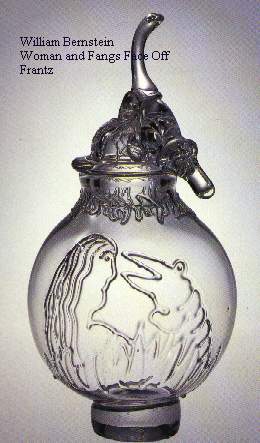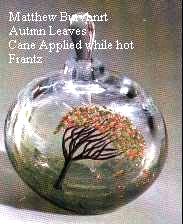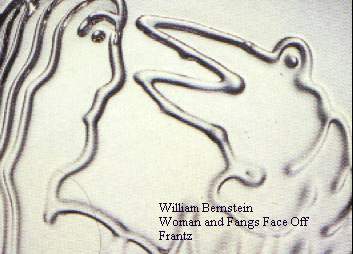|
Painting almost always is done on cold glass which afterward may
be fired to various temperatures depending on the material. Reverse
painting on glass is a centuries old traditional craft which does not involve
firing, but does require the skill of painting the foreground first and working
to the background - glass provides a "canvas" with depth. Sites:
A
B
Drawing on glass is almost always
done with a thin stringer of glass and a torch on a hot glass form that has to
be returned to the glory hole periodically although drawing-like images may be
created with thin painted lines.
Painting on glass has two major divisions depending whether the
paint is heated for setting/firing. If the paint is not fired, then the
paints used are like ordinary sign painting enamels. The glass may be
lightly sanded for grip. Usually the technique is done by reverse painting
to take advantage of the transparency of the glass. Sometimes it is
painted on both sides. Reverse painting on glass requires that the artist
think and work in the reverse of painting on canvas or other opaque materials:
The foreground items are painted first then the mid-ground is laid on, then the
background is painted over all. For more information go off to
Reverse Glass Painting
There are available some modern paints that are fired at the
temperature of a household oven or at about 700F. I know little about
either of these, but they are typically front painted and may be applied by
stencil or silk screen as well as brush. They are normally used for
decorative items and are baked to increase durability. Here are a couple
of reference pages USING
PAINTS THAT DON'T NEED TO BE FIRED IN A KILN
The first of the truly fired glass painting techniques is the
antique stained glass. Here a silver compound is painted on the glass and
when fired the compound chemically bonds with the glass and produces a variously
dark image ranging from yellow to dark brown. Traditionally, this is used
to provide details on a piece of glass that is producing the color tone for face
or hair or clothing. Once fired, it can not be removed from the glass
although additional stain can be added to darken details further.
This process is rarely done today with richer detailing possible with paints
like those below. People doing stained glass today are normally referring
to the assembly of colored glass without additional painted details.
Painting on glass in color to be fired is normally done with
enamels, which are compounds of colors and components like that of glass, but
with more color and fluxes and less silica. These are similar to copper
enameling materials but are formulated to match the expansion of glass.
Many have lead oxide added for more flexibility but like pottery, if these are
used on the surface exposed to food or drink, they can't be sold in many places.
Most glass enamels must be fired at high enough temperatures that the glass must
be heated to near the annealing point, then flash heated to melt the enamel on
the surface without deforming the glass, the temperature then being dropped to
the annealing point quickly. 2008-02-11
|


 An
example of drawing, in this case with clear glass, by William Bernstein as
published in
An
example of drawing, in this case with clear glass, by William Bernstein as
published in